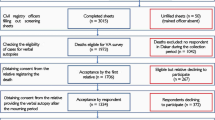Summary
The question whether an autopsy could have been omitted without adversely affecting diagnostic accuracy in cases in which an unnatural death was not suspected, was investigated by evaluating data from the files of cases handled in 1977 at the Government Department of Forensic Medicine in Uppsala in which the police had requested a simple medicolegal examination. The police report and the result of an external examination were evaluated blindly and cases divided into three groups. In 95 cases (12%) no autopsy, in 360 cases (45%) a partial autopsy, and in 346 cases (43%) a complete autopsy was considered necessary. In three of the 95 cases and in four of the 360 cases a wrong diagnosis was made. In 59 cases (7%) a complete medicolegal examination was performed. In 21 of the latter the circumstances of death were obscure and in 11 of these an unnatural cause of death was found.
The investigation confirms that all cases must be handled by skilled medicolegal experts, that the extent of the medicolegal examination can well be assessed by the physician in charge, and that the autopsy procedure can be simplified in many cases and omitted in some, especially in a situation where resources are limited, without significantly affecting diagnostic accuracy in the individual case. However this policy adversely affects scientific studies on larger autopsy material.
Zusammenfassung
Anhand der Fälle, bei denen die Polizei eine einfache rechtsmedizinische Untersuchung am Staatlichen Rechtsmedizinischen Institut in Uppsala verlangt hatte, wurde die Frage untersucht, ob man auf eine Obduktion in Fällen ohne Verdacht auf unnatürlichen Tod ohne Verlust diagnostischer Zuverlässigkeit verzichten kann. Polizeiberichte und Resultate der äußeren Besichtigungen bewertete man pauschal und teilte die Fälle in drei Gruppen ein. In 95 Fällen (12%) wurde keine Obduktion, in 360 Fällen (45%) eine begrenzte Obduktion und in 346 Fällen eine vollständige Obduktion als notwendig erachtet. Bei drei der 95 Fälle und vier der 360 Fälle wurden Fehldiagnosen gestellt. In 59 Fällen (7%) wurde eine vollständige rechtsmedizinische Untersuchung durchgeführt. In 21 dieser letzteren Fälle waren alle Umstände unklar; man stellte einen unnatürlichen Tod in 11 Fällen fest.
Das Untersuchungsergebnis zeigt: 1. Alle Fälle müssen von erfahrenen rechtsmedizinischen Sachverstä ndigen untersucht werden. 2. Der Umfang der jeweiligen rechtsmedizinischen Untersuchung kann vom verantwortlichen Arzt bestimmt werden. 3. In besonderen Fällen kann die Obduktion vereinfacht werden. In einigen individuellen Fällen kann man sogar von ihr ohne Verlust der diagnostischen Zuverlässigkeit absehen. Dieses Vorgehen wirkt sich jedoch auf wissenschaftliche Untersuchungen an größerem Obduktions-material nachteilig aus.
Similar content being viewed by others
References
Turkel HW (1953) Merits of the present coroner system J Am Med Assoc 153: 1087–1092
Paton BC (1957) The accuracy of diagnosis of myocardial infarction: a clinicopathologic study. Am J Med 23: 761–768
Heasman MA (1962) Accuracy of death certification. Proc Roy Soc Med 55: 733
Wikland B (1971) Medically unattended fatal cases of ischemic heart disease in a defined population. Acta Med Scand Suppl 524
Patel NS (1972) Study on suicide. PhD Thesis, University of London
Britton M (1974) Vad händer när anhöriga underrättas om planerad obduktion och hur viktiga är obduktionerna (What happens when relatives are notified of intended autopsy and how important are autopsies?) Academic Thesis, Karolinska Institutet, Stockholm (summary in English)
Britton M (1974) Diagnostic errors discovered at autopsy. Acta Med Scand 196: 203
Virkkunen M, Penttilä A, Tenhu M, Huittinen VM, Lehti H, Rissanen V, Uotila U (1975) Comparative study on the underlying cause and mode of death established prior to and after medicolegal autopsy. Forens Sci 5: 73–79
Author information
Authors and Affiliations
Rights and permissions
About this article
Cite this article
Gerdin, B., Lindquist, O. Comparison Between Predicted Cause of Death and Cause of Death Found at Autopsy in Medicolegal Autopsy Material. Z Rechtsmed 85, 181–187 (1980). https://doi.org/10.1007/BF02116318
Received:
Issue Date:
DOI: https://doi.org/10.1007/BF02116318




